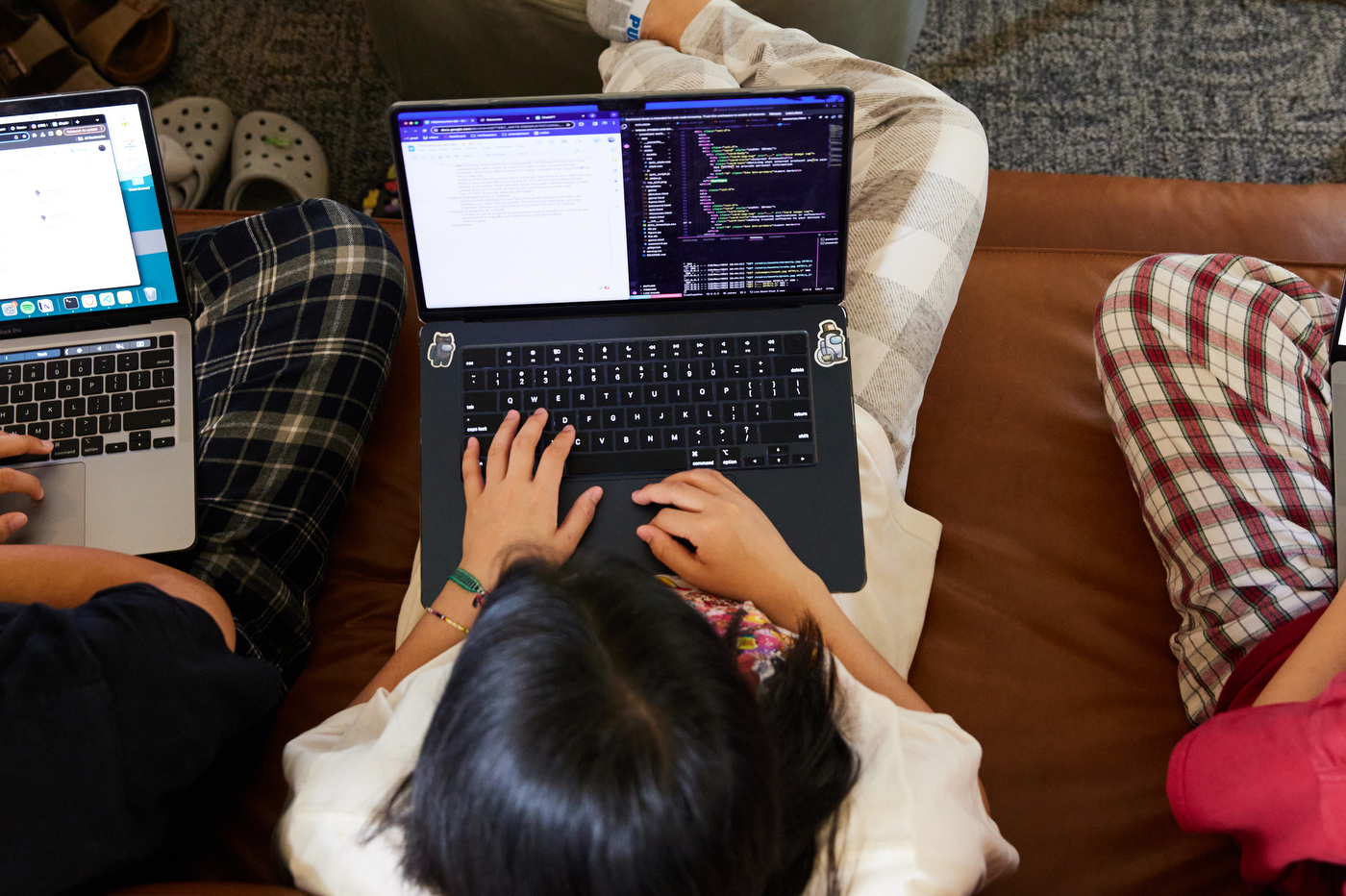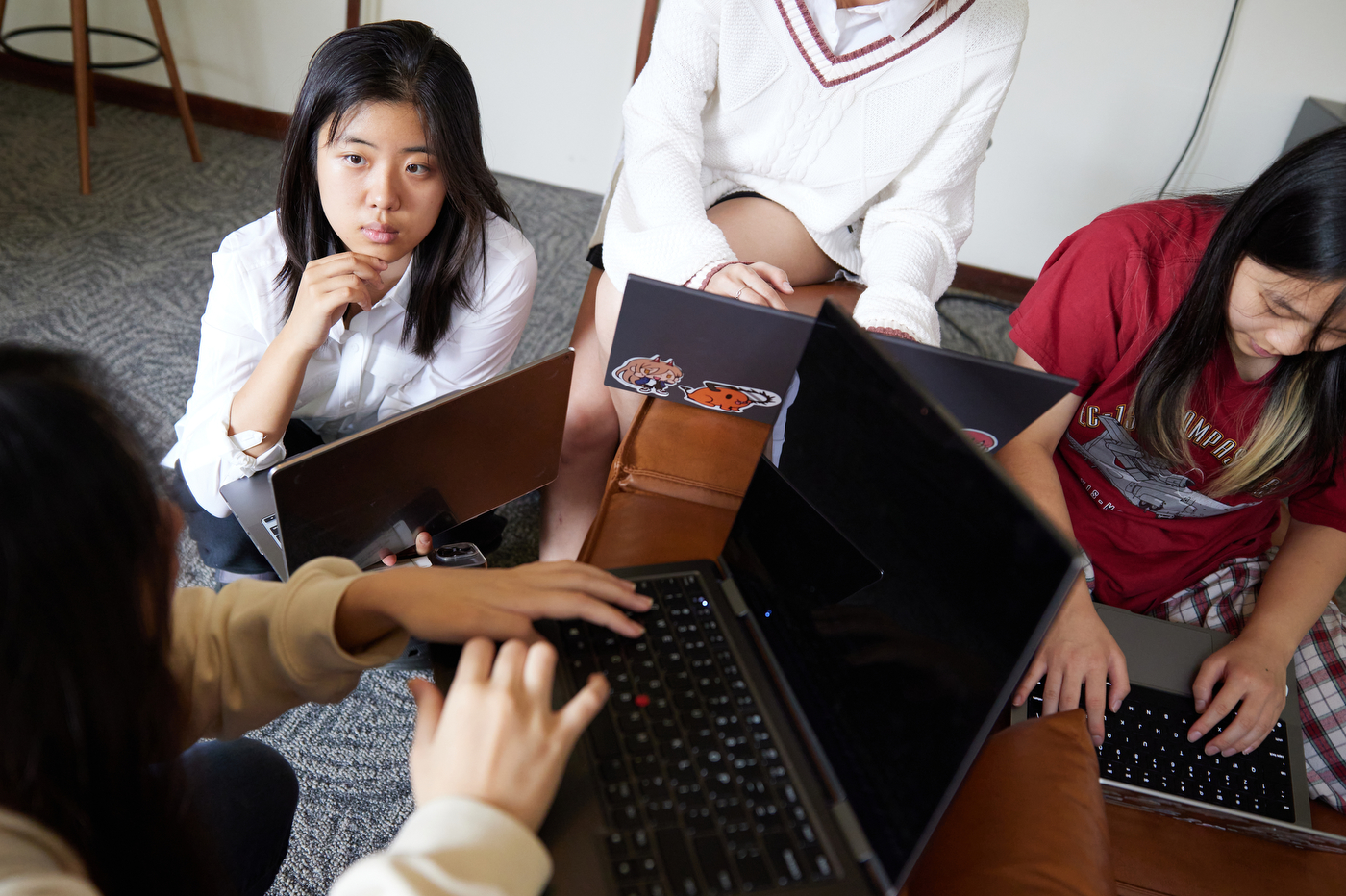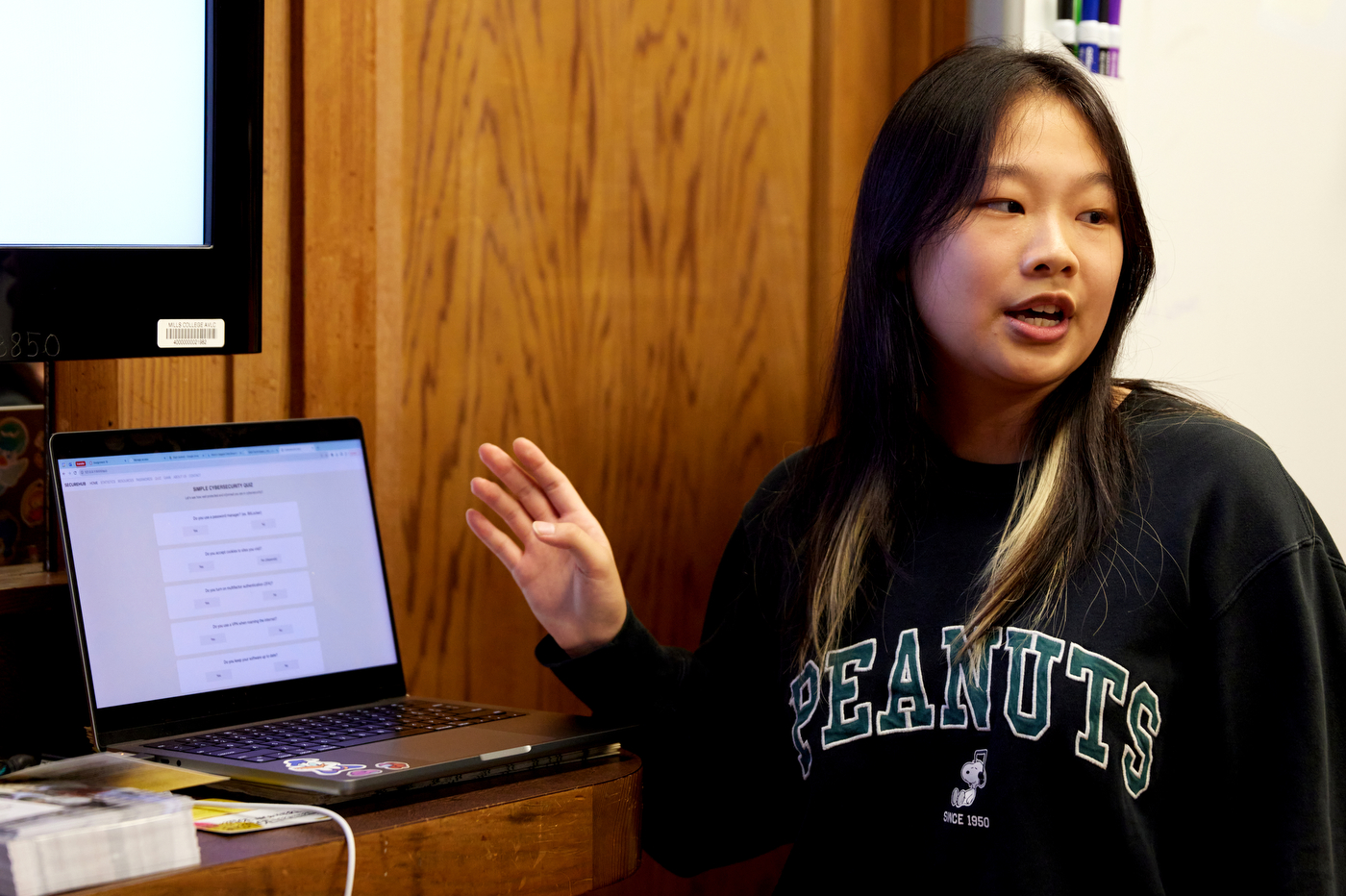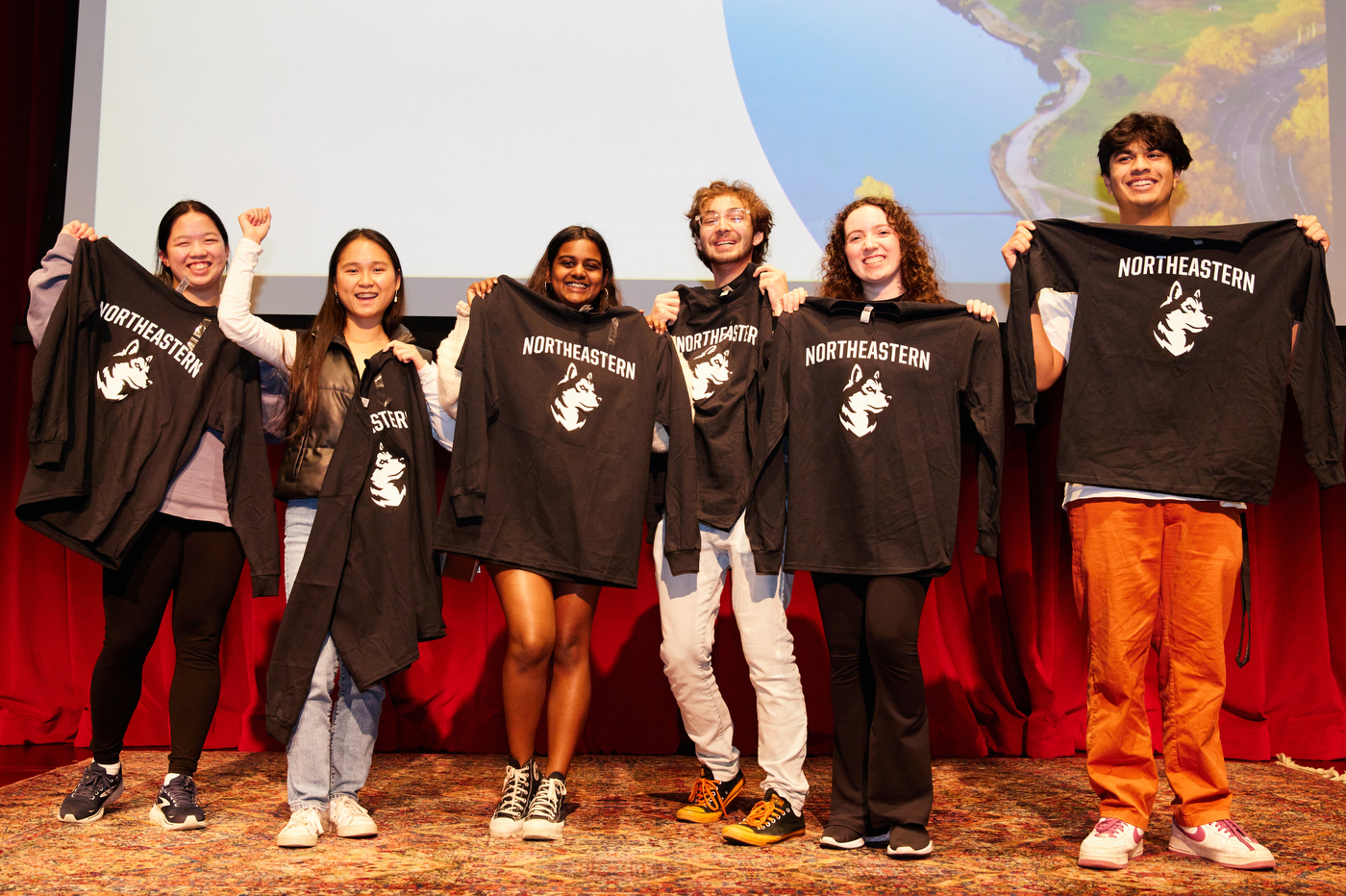Experiential entrepreneurship summit keeps Oakland students up all night writing code, solving problems

OAKLAND, Calif. — Rain sprinkled and then streamed down the windows of the Student Union where a couple of dozen students hunkered down at sunset, armed with pizza, laptops and a challenge: identify real-world problems affecting their community and design marketable solutions, complete with digital mock-ups, in less than 24 hours.
It was going to be a long night.
The inaugural “Experiential Entrepreneurship Start Summit: Hackathon for the Benefit of the Oakland Community” kicked off last week on Northeastern’s Oakland campus where four teams of students collaborated in marathon work sessions to create products that would address issues in health, wellness, sustainability and cybersecurity.
Electrical and computer engineering professor David Horsley was joined by head of entrepreneurship Shea Tate-Di Donna and assistant director of entrepreneurship Chung Xiong in supporting the students, most of them freshmen majoring in everything from computer science to business administration.
Turning theoretical classroom instruction into practical application is a key part of the Northeastern experience and comes on the heels of October’s Experiential Entrepreneurial Trek Days, where 800 students toured over 30 Bay Area businesses.




“The biggest takeaway is seeing students get excited about applying their skills,” Xiong said. “Not just being in a class but getting to create something they can own and name.”
And create they did. The students used technology tools, guidance from industry experts and one another to create a nutrition-tracking app, interactive map and cybersecurity website after a night of intense brainstorming and implementation.
Some slept and some didn’t.
“I actually got a good amount of sleep,” said Dharana Alilaikannan, a first-year computer science major who helped create HuskyPedia, a website with an interactive map of landmarks to teach Northeastern students about the rich history of the Oakland campus.
Alilaikannan’s group, Team Sage, found through student surveys that many Northeastern students don’t know the history of the campus that is now their home.
“All the students coming to campus have no idea what is happening in each building,” said Danny Sklyarevskiy, the team’s engineer, who wrote code for the site.
Using a tech stack that included Google Drive for collaboration, Canva for content creation, Wix to build websites, Ideogram as an AI photo generator and project management tools Trello, Miro and Asana, Sklyarevskiy and his team achieved a functional website in 24 hours that was attractive, user friendly and just plain fun.
The biggest takeaway is seeing students get excited about applying their skills. Not just being in a class but getting to create something they can own and name.
Chung Xiong, assistant director of entrepreneurship
Just as fun as the process of making it. Collaboration was one of the soft skills the students were practicing, along with other “community agreements” like inclusivity, boundaries, open-mindedness, normalizing failures and addressing conflict appropriately.
“Being up with the people and collaborating with them, it’s just fun,” said Alilaikannan, who is also a Husky ambassador. Giving tours on campus helped her contribute content for the site, which included fun facts about each building.
Team Scavenger took on a different problem — illegal dumping, an issue that plagues large urban cities.
“Let’s talk trash, OK?” said Haseeb Khan, a graduate student majoring in information systems, who helped present “Thispose,” a trash-collecting game similar to the Pokemon street game, where players can rack up points by photographing, categorizing and properly disposing of landfill, recycling and compost.
“We found that waste was something we could do something about,” Khan said, who cited Figma, ReactNative, Flask and OpenCV as technology tools they used to imagine a camera app able to identify trash accurately.
Khan appreciated Northeastern’s commitment to offering its students the opportunity to test their skills on real projects. Networking with industry leaders isn’t so bad either.
“Part of the process for choosing this campus was the exposure to startups,” he said. “Getting information and insights from them directly through Northeastern is always a good idea.”
Two such industry leaders were Sam Atavi-Irvine, founding director for the Center for Community Engagement at Samuel Merritt University; and Michael Grosack, global head of content policy at YouTube. Both experts helped students refine their project ideas, navigate technical challenges and keep them on track.
Meanwhile, mentors offered advice on time management and workflows, helping the students meet their deadlines. The mentors included Gabbie Whittle, founder of Relevé, a women’s footwear company; and Kasi Viswanath Vandanapu, a computer science researcher.
The event was called a hackathon, but it wasn’t just about computers and coding.
“I kind of avoided the hackathon because I thought it was mainly for coding and I don’t know anything about coding,” said Serenity Chu, a first-year business administration major and a leader on Team Wegie. “But I learned enough to be able to run the website.”
The surge in confidence the students experienced was not lost on university leaders.
“The students do not just learn, they lead,” Tate-Di Donna said. “By navigating the unexpected and embracing the unknown, they are not just coding solutions, they are coding their future.”
Chu and her team created Securehub, a cybersecurity website targeted to millennials. To reach that audience, Chu helped to create a persona they could relate to: a technologically reckless millennial named Lily.
Lily is 29, lives in Oakland and earns $60,000 a year. On the lower income bracket for the pricey Bay Area, Lily shops on bargain websites, accepting all their cookies. Her passwords are simple and very hackable.
Her data is hanging out there for anyone to hack.
“It was fun creating Lily,” Chu said. “Putting my introduction to marketing classes into use, I was able to compose a persona to create a target audience.”
“For people like Lily, she’s only one needle in the haystack,” agreed Jasmine Yuen, who demonstrated how the website worked. “Eventually big corporations will realize they have to be more ethical about their data usage.”
Securehub can help people like Lily with a cybersecurity quiz, identifying their technological blind spots, a password analyzer and a resource library.
The students had to collect themselves to perform public speaking after a marathon working session, and received one-on-one help and encouragement from Iara Peng, founder of JustFund, the nation’s first common application for grant funding.
And Saturday morning was crunch time — presentations were due at 3 p.m. sharp, no exceptions.
Aileen Ruan presented Team Evergreen’s project on time by using an existing product called Fitness Pal as inspiration in designing a more simple nutrition-tracking app. Unlike others, which rely on the user-input data, all Team Evergreen’s app requires is uploading a photo of your food.
“I don’t personally look into the details of what I’m eating before I eat it, but with uploading a picture it would be easier to track,” Ruan said.
After presentations, groups assembled in Lisser Hall for judging.
Team Sage took first prize, the judges praising the members for having the most complete working demo, a QR code that linked to their website and demonstrating balance between graphic design, coding and user surveys.
But all the hackathon teams were clear winners.
“I couldn’t have asked for a better group for the first hackathon at Northeastern (Oakland),” said Tate-Di Donna from the stage as tired but proud students took their prizes of Husky T-shirts.
Horsley agreed.
“Next year there will be twice as many people,” he predicted. “You can say you were the first.”
“The most rewarding part for me personally is watching the students’ engagement, drive and commitment,” Tate-Di Donna said. “For most of the students, this was their first time participating in a hackathon, and, after this 24-hour sprint to build, they are already planning their next!”
Xiong reminded the students of one last task — something no successful professional should ever forget — to thank the people who helped them.
He put up a QR code that guided them to the expert, mentor and student volunteer contacts.
“Take the time to write a thank you note,” he said.






